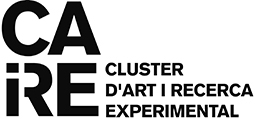The driving group of CAiRE is composed by the following research groups and center:
Digidoc – Interactive Communication, UPF
The Interactive Communication section of the Digidoc Research Group belongs to the Department of Communication of the University Pompeu Fabra. Its main interest is the intrinsic discursive forms of interactive digital environments.
The group addresses the study of these forms from a dual and complementary perspective combining experimental production and theoretical reflection. The interest of the group has always been focused on cultural dissemination and education, without neglecting the potential of interactive communication proposals coming from an artistic or social perspective.
DARTS, UOC
DARTS develops research on the intersections among art, design, techno-science and society. DARTS Group is made up of researchers, artists, designers, philosophers, art historians, multimedia engineers, computer scientists and telecommunication professionals.
DARTS works on three interconnected lines:
– Epistemology and methodology of the arts
– Relationship between Arts and Education
– Interrelation between Art, Science and Technology and Society.
GRETA – Research Group in Aesthetics and Art Theory, UAB
The Research Group in Aesthetics and Art Theory – GRETA Consolidated Group of the Catalan Goverment SGR-360- 2,014 research focus is where theory of art and design, philosophy and historical studies converge. Its main focus is contemporary aesthetics from an applied perspective. Its main research areas are: a) the transformations of aesthetic experience in contemporary culture; b) the blurring boundaries between different artistic media; c) comparative study of creative processes in order to better understand the conditions for creativity and innovation to emerge.
HANGAR – Visual Art Production and Research Center
Hangar is a centre for art research and production, offering support to artists.
Hangar’s mission is to support the visual artists and creators during the different phases of their art production processes as well as to contribute to the best development of their projects. For doing so, Hangar facilitates them equipments, facilities, production assistance and a suitable context for experimentation and free knowledge transfer.
The centre offers an array of services and a framework that allows for the research and development of art productions in their entirety, or partially. Hangar follows up on the results by including the projects in various networks and platforms, or by detecting possibilities for their incorporation within other fields.
IMARTE – Research Group in Art, Science and Techmology, UB
The Imarte Research Group first started taking part in competitive projects in 2000. We have been able to create different research lines ever since, all of which are based on artistic production, to analyze the changes in the meaning of art and the influence of digital technologies in its processes. Artistic research today establishes a shared code that is not limited to a single model but implies a dynamic space in which different methodologies take part, and by doing so contributes to the accumulation of knowledge. Certain debates have appeared in the contemporary art context, which challenge the changes that happen in new forms of artistic practice. This fact has driven us to analyze new tools, technologies and ideas that as creative strategies have opened up the following research lines:
Binary prospections: Artistic production, art and technology
Expanded printing: Artistic production, art, technology and printing.
Metamethods: Art and research. Shared methodologies.
Our aim is, on the one hand, to tackle the analyse of the changes produced in the concept of art and its role within the knowledge society, and on the other hand, to intervene in the transformation of the artistic praxis, which happens in the context of the new production conditions.



